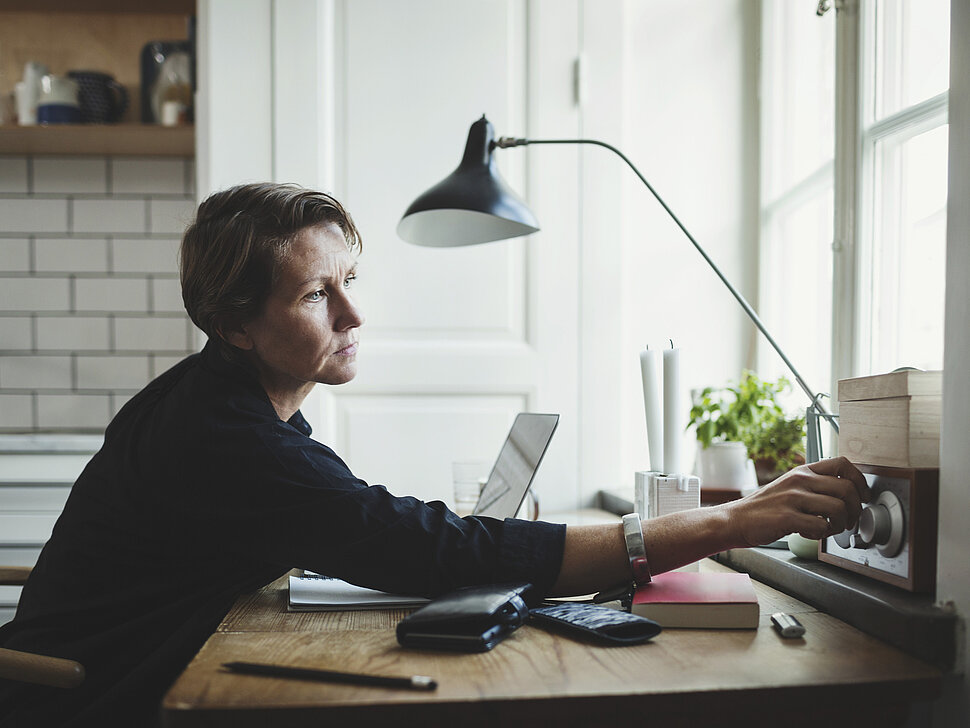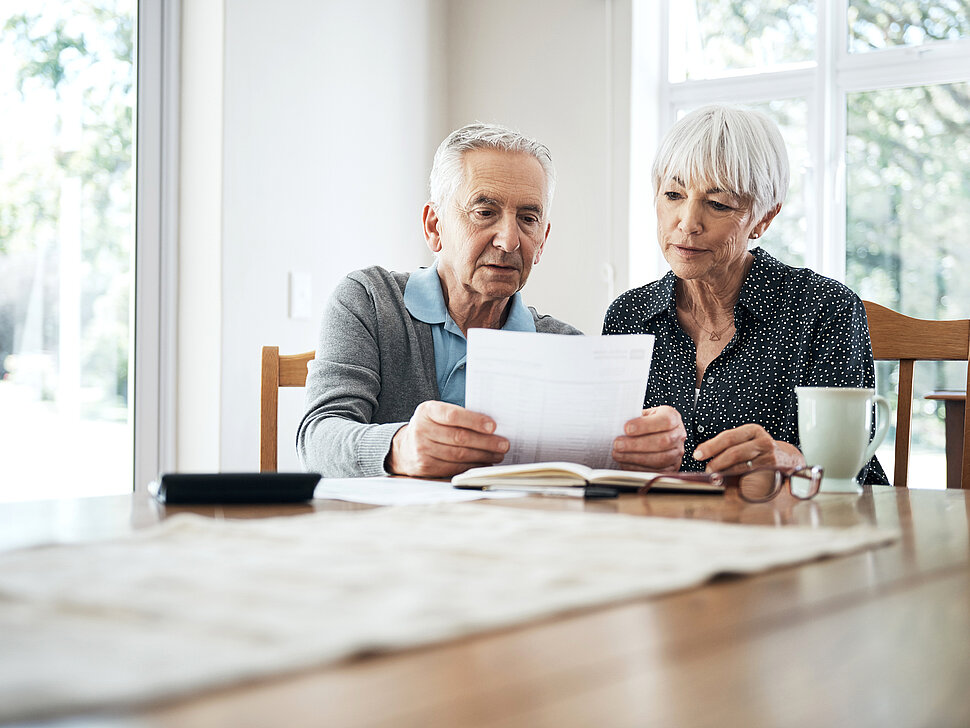Saving Gas and Electricity at Home
Reading time: 10 min
Now more than ever, it’s essential to save gas and electricity. If we want our gas supplies to last through the winter, Germany needs to reduce its energy consumption by at least 20 percent. And you need to play your part, too: economizing is never fun, but there are a number of small-scale measures you can take that together add up to major savings. Given the rapid rise in prices, your bank balance will thank you as well. Some of these measures can be implemented right away and won’t cost you a cent; others require a small amount of installation – or a change in your behavior.
Throughout Your Home
In the wintertime, it’s a particular relief to come home to a warm, cozy apartment. But this comes at a price: around 70 percent of a household’s energy consumption goes towards heating the home. So it’s worth making a few changes.
Keep Radiators Unobstructed and Bleed Them
Take a look at the situation in each room. Are your radiators unobstructed, letting the heat flow freely into the room? If they have any large furniture or heavy curtains in front of them, a little rearrangement will save both energy and money – potentially, up to 12 percent.
Do your heating pipes gurgle? Sounds like your radiators need bleeding. You can do this yourself – it takes around five minutes and costs nothing. Yet regularly bleeding your radiators can cut your annual heating costs by up to 15 percent.
Reduce the Room Temperature
Try having your living space one to two degrees cooler. Does it still feel OK to you? Every degree you trim from the room temperature lowers heating costs by six percent. Plus, the rooms in your apartment don’t all need to be equally warm. The German Environment Agency recommends a temperature of 20 °C (68 °F) in your living room, 18 °C (64 °F) in the kitchen and 17 °C (63 °F) in the bedroom. If particular rooms are staying empty for an extended period, you can bring the temperature down to 17 °C (63 °F).
Install Smart Thermostats
With electronic thermostats, you can control room temperature precisely. Many of these devices can be programmed via smartphone, allowing you to select specific times for heating. Investing in one of these costs around 100–150 euros.
Shut Your Doors
Clearly, differing room temperatures are only helpful if the warm air in your living room isn’t escaping into the hallway or bedroom through an open door. If possible, all doors to rooms that are heated more should be kept closed. You should also insulate doors leading to unheated rooms like the cellar or attic, using elastic sealing strips for the bottom edge, movable sealing strips, or brush seals.
Seal Your Windows – and Ventilate Properly
In older buildings in particular, your precious warm air is liable to drain away through poorly sealed windows. You can fill in window gaps with rubber insulation strips or foam sealing tape from your local hardware store. Curtains, roller blinds, and venetian blinds don’t just keep out the heat in summer – they can also help prevent it from escaping. So it’s worth drawing the curtains in your living room and study each evening.
Ventilation is essential – particularly if you’re now deliberately keeping certain specific rooms cool. In cold rooms in particular, moisture builds up. Here, shock ventilation is better than continuous ventilation. Before ventilating, turn down the thermostat for the heating, otherwise the temperature sensor will react to the cold air from outside and ramp up the heat.
Optimize Your Heating Control
Modern heating systems are capable of automatically lowering the temperature overnight or bringing it down by a few degrees on weekdays when there’s nobody home. This means you’ll only have the heating on high at times when you actually get some benefit from it – saving you up to 15 percent in energy costs in the process.
In the Bathroom
Check the Clock
Water heating accounts for some 14 percent of household energy expenditure[KT1] . An eight-minute shower at 38 °C (100 °F) uses 100 liters of water. Over the course of a year, this adds up to over 500 euros per person. You can save energy and money by cutting showering time to five minutes and by adjusting the water setting so it doesn’t get quite so hot.
Install a Low-Flow Shower Head
Here’s a small extra investment (starting at around 20 euros) that can help you save even more. A low-flow shower head with a smaller head and a flow restrictor simply won’t let as much water through as a regular shower head, cutting your hot water costs by up to 30 percent. Alternatively, there are also shower heads and spray faucet attachments that mix air in with the water so that when you shower, you’ll use less water without any compromise on comfort.
Have a Cold Wash from Time to Time.
From a hygiene standpoint, it’s perfectly okay to use cold water and soap when washing your hands and face. Your skin will thank you too: dermatologists have long been warning that too much hot water dries out the skin.
In the Kitchen
Climate-Friendly Cooking
Every pot has a lid, and using it can cut your energy consumption by up to two thirds.
It’s also fine to switch off the burner a few minutes before your food is cooked. It will finish cooking just fine with the residual heat.
Using the convection air function when baking or roasting in the oven will cost you 15 percent less energy. Most recipes specify the temperature for using top and bottom heat. With convection, you can take that down by about ten percent.
Convection also allows you to use several levels of your oven at once and prepare several dishes at the same time. You don’t always need to pre-heat either, and doing without this can cut energy consumption by up to eight percent.
You can save additional energy in the kitchen by installing a faucet aerator. It’s also okay to use cold water for washing fruit and vegetables and your own hands.
Clean Plates, Clean Conscience
A dishwasher feels like a little touch of luxury. Now here’s the good news: use it properly and it’ll even help you save. Compared to dishwashing by hand, a dishwasher uses up to 50 percent less energy and up to 30 percent less water – though only with a full load.
Be sure to use eco mode: it might take longer to run, but it uses less energy. One tip is to let it run overnight if possible – then it doesn’t matter how long the cycle lasts.
Stay Cool – But Not Too Cool!
Do you know how cold your refrigerator is? The average setting for refrigerators in Germany is 5.8 °C (42.5 °F) – that’s about one degree too cold! For the refrigerator 7 °C (45 °F) and –18 °C (0 °F) in the freezer are perfectly sufficient. For each degree of refrigeration, you’re using six percent more power and it won’t even keep your food fresh longer. Regular defrosting also helps keep your power consumption under control – an iced-up refrigerator uses around 15 percent more electricity.
When stocking and emptying the refrigerator, it’s better not to leave the door open for minutes at a time. Especially if the kitchen is warm because you’re cooking or baking something. And cooked food should always be allowed to cool down fully before putting it in the refrigerator.
Doing the Laundry
Wait until you have enough laundry for a full load – even if it means doing without that favorite T-shirt for a few days. You can also save energy by selecting eco mode and mostly using lower temperatures, because heating the water is what uses the most energy. For most clothing, washing at 30–40 °C (86–104 °F) is plenty, as well as being kinder to the fabric. A wash at 60 °C (140 °F) is only necessary for bedlinens, towels, and really dirty clothes.
Dryers, especially the older ones, use a great deal of power – costing up to 1.50 euros per drying cycle. On the other hand, drying your clothes on a good old clothesline or drying rack costs nothing at all.
In Your Home Office
Do you keep our computer, monitor, and printer on standby even though they’ve been idle for hours or even days? And let’s not forget those electronic entertainment devices that make life more enjoyable after work – gaming consoles, TVs, receivers, and the like. Standby mode alone accounts for ten percent of electricity consumption in German households. Having everything on a single switchable power strip is a simple, easy way to make savings here. Just switch the whole strip off when you leave the room, the same way you already do with the light.
In the Cellar
You might not spend much time your home’s cellar, but don’t leave it out of your calculations. A lot of energy is wasted by uncovered heating pipes. Pipe insulators from the hardware store won’t cost you much and can be installed without major effort.
If you’re willing and able to spend a bit more time and money, insulating the cellar ceiling is also good investment – your feet will stay warmer on the ground floor, and you’ll save up to seven percent in energy.



